 |
 |
 |
 |
 |
 |
| |
 |
|
 |
 |
 |
  |
  |
 |
 |
 |
 |
|
|
 |
|
 |
 |
 |
BUILDING |
 |
|
 |
|
 |
 |
 |
| |
 |
| 
 |
MUMUTH - Haus für Musik und Musiktheater
Music Theatre |
|
 |
 |
 |
 |
DESIGNER |
 |
|
|
 |
|
 |
 |
 |
| |
 |
|
 |
 |
 |
 |
DESCRIPTION |
 |
|
|
 |
|
 |
 |
 |
| Project Music Theatre |
 |
|
 |
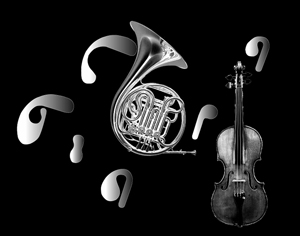 The relationship between music and architecture is a classical one. Too classical for our times, may be the thought of many contemporary architects. But that is not our view; UNStudio likes classical with a twist… The theme of the acoustic space, explored for its dramatic potential by Le Corbusier and Xenakis is still to us a topic of fascination and incredible potential today. And since the MUMUTH theatre belongs to the University of Graz and is therefore a place where young musicians receive their instruction in the performing and musical arts, it seems to us even more appropriate to let the architecture communicate that this is a building in which music lives. The relationship between music and architecture is a classical one. Too classical for our times, may be the thought of many contemporary architects. But that is not our view; UNStudio likes classical with a twist… The theme of the acoustic space, explored for its dramatic potential by Le Corbusier and Xenakis is still to us a topic of fascination and incredible potential today. And since the MUMUTH theatre belongs to the University of Graz and is therefore a place where young musicians receive their instruction in the performing and musical arts, it seems to us even more appropriate to let the architecture communicate that this is a building in which music lives.
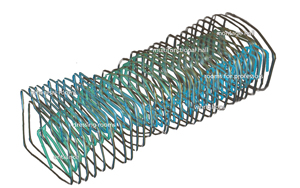 This desire to make a building that is as much about music as a building can be, has been a constant throughout the nearly ten years that it took to build it. Although the project outwardly has changed considerably since its inception, the two themes that are at the basis of the building and its overall organization have endured. This desire to make a building that is as much about music as a building can be, has been a constant throughout the nearly ten years that it took to build it. Although the project outwardly has changed considerably since its inception, the two themes that are at the basis of the building and its overall organization have endured.
The first of these two themes is the so-called ‘spring structure’ which bears the most direct relationship to music. In the first stage of the competition, the design was still very conceptual and was envisaged as an elongated spring of varying diameter size, which would alternately be stretched, suppressed and folded up inside itself to offer structure to the various volumes that together make up the theatrical, audience, rehearsal and utility spaces. We saw the spiral as the organising element of the MUMUTH in much the same way as Serialism works in contemporary music; the continuous line absorbs and regulates intervals and interruptions, changes of direction and leaps of scale without losing its continuity. Things hang on this line like laundry: glass, concrete and installations. In many ways this principle still holds, although in the building as it stands today the coil motif is no longer prominently displayed on the facades, as it was in that first conceptual design, but is now invisibly absorbed in the construction.
In fact, the legibility of the spring was dissolved only gradually. The design that was made for the second stage of the competition shows a refined spiral concept, which, like an octopus, is simple, orthogonal and horizontally orientated on one side and turns into a complex, smaller-scaled principle on the opposite side. This principle of a spiral that divides itself into a number of interconnected smaller spirals that take on a vertical and diagonal direction became an important design model for us which we called the blob-to-box model. It illustrated in a simple line diagram how a building could be structured to combine within one, rigorous gesture a strict, unit-based volume (the black box of the theatre) and a series of flowing, movement-based volumes (foyer and public circulation). Because this organising principle is made constructive, a free, fluent internal spatial arrangement is actualised, efficiently connecting spaces to each other. And, like the spring structure, the blob-to-box motif also remains a core principle of the final building. The theatre has a public character which is dynamic and which facilitates groups of people moving through it during events, and it has a calm, quiet, intense, but also very flexible and rational character which is related to the specific prescriptions of the auditorium and the rehearsal studios.
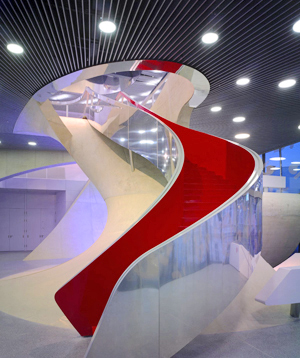 The unit-based part of the organization (the box) is situated on the right side and the movement-based part (the blob) on the left side of the building as seen from the Lichtenfelsgasse. There are two entrances; the everyday entrance on the park side which is used by students and staff, and the public entrance on the Lichtenfelsgasse which is used by the audience when there is a performance. On performance nights, the student entrance is transformed into a wardrobe using mobile closets. A removable ticketing desk and screen bulletin are placed underneath the staircase. The public ascends a wide staircase and enters a large foyer on the first floor. This foyer gives access to the multipurpose auditorium that can seat up to 650, and that is adaptable to a great variety of performances, ranging from solo instruments to dance, to full orchestra. The unit-based part of the organization (the box) is situated on the right side and the movement-based part (the blob) on the left side of the building as seen from the Lichtenfelsgasse. There are two entrances; the everyday entrance on the park side which is used by students and staff, and the public entrance on the Lichtenfelsgasse which is used by the audience when there is a performance. On performance nights, the student entrance is transformed into a wardrobe using mobile closets. A removable ticketing desk and screen bulletin are placed underneath the staircase. The public ascends a wide staircase and enters a large foyer on the first floor. This foyer gives access to the multipurpose auditorium that can seat up to 650, and that is adaptable to a great variety of performances, ranging from solo instruments to dance, to full orchestra.
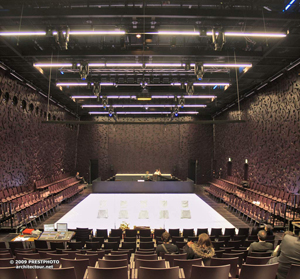 The free-flowing space of the foyer is made possible by a spiralling constructive element that connects the entrance to the auditorium and to the music rooms above, thus welding together ‘with a twist’ the three levels of this side of the building. The twist is in fact a massive concrete construction which was one of the most challenging we ever realized – more difficult to achieve even than the twists in our recently completed museum for Mercedes-Benz. The dimensions of this particular twist necessitated far greater precision and the use of self compacting concrete which was pumped up from below instead of poured down from above as is the usual method. The twist forms a central feature of the public space, around which everything revolves. Lighting and material details accentuate the ripple effect. The twist is highlighted from above by a skylight in the ceiling, which itself consists of lamellas executed in dark wood which fan out from the twist in a wave-like pattern. The free-flowing space of the foyer is made possible by a spiralling constructive element that connects the entrance to the auditorium and to the music rooms above, thus welding together ‘with a twist’ the three levels of this side of the building. The twist is in fact a massive concrete construction which was one of the most challenging we ever realized – more difficult to achieve even than the twists in our recently completed museum for Mercedes-Benz. The dimensions of this particular twist necessitated far greater precision and the use of self compacting concrete which was pumped up from below instead of poured down from above as is the usual method. The twist forms a central feature of the public space, around which everything revolves. Lighting and material details accentuate the ripple effect. The twist is highlighted from above by a skylight in the ceiling, which itself consists of lamellas executed in dark wood which fan out from the twist in a wave-like pattern.
With the overt presence of the spring receding from the facade as the design evolved, the exterior again became a blank canvas, generating the opportunity to return to the theme of music in a new way. Our interest in re-establishing a relationship between music and architecture had from the beginning focused on shared aspects such as rhythm, continuity, channelling. Through our readings of the philosopher Gilles Deleuze we learned that there is another element that we had not seriously studied before: the element of repetition. Repetition generates an aggregate with densifications, intensifications and intervals. Repetition brings sonority. It allows for improvisation, it marks territory, it codes milieus. We decided to use a repetitive pattern, of our own design, and apply this to the facades in various ways to achieve some of these effects. The pattern, executed in the muted tones of stage make-up, is found all over the building in various degrees of density. Its appearance is furthermore impacted by changes in light during night and day, as well as by proximity and view angles since the outermost layer of the façade consists of a glittering mesh.
Ben van Berkel
Caroline Bos |
|
 |
 |
 |
|
 |
|
|
|
 |
|
 |
 |
 |
|
 |
|
| Profile MUMUTH |
 |
|
 |
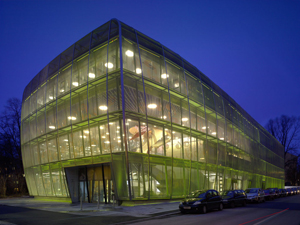 After decades of political struggles, MUMUTH of the University of Music and Performing Arts Graz (KUG) shall be inaugurated officially on March 1, 2009 to offer from this day on not only room for top-level education in the field of the arts but to allow students also to have the “dress rehearsal” of their future careers in an unmistakable venue, viz. to appear in public under professional conditions. After decades of political struggles, MUMUTH of the University of Music and Performing Arts Graz (KUG) shall be inaugurated officially on March 1, 2009 to offer from this day on not only room for top-level education in the field of the arts but to allow students also to have the “dress rehearsal” of their future careers in an unmistakable venue, viz. to appear in public under professional conditions.
As some sort of innovative platform for a discourse of modernity, MUMUTH will be the place for high-quality artistic productions and interdisciplinary events, a variable room as high-tech research laboratory of the arts. MUMUTH productions will always have an eye on contemporary trends animating this way KUG’s strategic goals of “Tradition and Modernity” and “Practice and Reflection”. So these events will help to accomplish even better the mission of a university to develop and unfold the arts.
MUMUTH will be available to all KUG institutes as a place to practice and to hold events. The fundamental concept rests not only on a wide range of activities, in the main for university-related purposes, but also on various non-university events matching the profile of the building. |
|
 |
 |
 |
 |
 |
 |
 |
VIDEO |
 |
|
|
 |
|
 |
 |
 |
| |
 |
|
 |
 |
 |
 |
MATERIALS |
 |
|
|
 |
|
 |
 |
 |
 |
 |
|
steel, glass, reinforced concrete
|
|
 |
 |
 |
 |
LOCATION |
 |
|
|
 |
|
 |
 |
 |

|
 |

|
Continent |
|
 |
|
Nation |
|
 |
|
State |
|
 |
|
Town |
|
 |
|
District |
|
 |
|
Address |
|
 |
|
|
|
 |
|
Website |
|
 |
|
 |
 |
 |
 |
MAP |
 |
|
|
 |
|
 |
 |
 |
| |
 |
|
 |
 |
 |
 |
|
TYPOLOGY |
 |
|
|
 |
|
 |
 |
 |
|
|
 |
ARCHITECTURE | Education buildings
Universities, colleges
Auditorium
Buildings for recreational activities
Auditoriums and music centres
| |
 |
 |
 |
 |
CHRONOLOGY |
 |
|
|
 |
|
 |
 |
 |
Project |
 |
|
 |
| 
 |
1998 - 2003
project winner of competition
|
|
Realisation |
 |
|
 |
| 
 |
2006 - 2008 |
|
 |
 |
 |
 |
BIBILIOGRAPHIC REFERENCES |
 |
|
|
 |
|
 |
 |
 |
|
 |
| "MUMUTH, House for Music and Music Theatre, Graz, Austria", A+U. Architecture and Urbanisme 473, february 2010 [Materials / Treatments], pp. 92-99 |
|
|
| Victoria Newhouse, "MUMUTH music theatre, Austria. UNStudio", Architectural Record 10/2009, october 2009, pp. 96-101 |
|
|
| "Haus für Musiktheater der Kunstuniversität Graz (KUG) / House for Music and Music Theatre of the University for Art in Graz (KUG)", Detail 6/2009 [Treppen, Wege, Rampen / Stairs, Ramps / Escaliers, rampes], "Dokumentation/Documentation" pp. 606-612, 690 |
|
|
| Richard Jones, "Musical twist: MUMUTH. Haus fur Musik & Musiktheater, Graz. UNStudio", Monument 91, june-july 2009 [New wave artisans: the next generation uncovered], pp. 64-71 |
|
|
| Anne Isopp, "A Van Berkel after all", A10 new European architecture 27, may-june 2009, "On the spot" p. 6 |
|
|
| Ulrich Tragatschnig, "MUMUTH Graz. Architektur subtiler Ubergange / MUMUTH musical theatre in Graz, Austria. Architecture of subtle transitions", Architektur Aktuell 350, mai/may 2009 [The Social Agenda], pp. 116-127 |
|
|
| Yehuda E. Safran, "MUMUTH, House for Music and Music Theatre. Graz, Austria. UNStudio / Ben van Berkel", The Plan 32, marzo/march 2009, "Architettura/Architecture" pp. 50-62 |
|
|
| UNStudio, "MUMUTH music centre in Graz, Austria", Arquitectura Viva 124, I-II 2009 [Banda ancha. Obras digitales: de la estructura a la piel], pp. 54-59 |
|
|
| "Music Theatre, University of the Arts 'Mumut', Graz, Austria. UNStudio", GA Document 97, june 2007 [International 2007], pp. 54-57 |
|
|
| Città: Less Aesthetics More Ethics. Padiglioni, Marsilio, La Biennale di Venezia, Venezia 2000, "Austria" p. 122 |
|
 |
 |
 |
 |
 |
 |
 |
CLIENT |
 |
|
|
 |
|
 |
 |
 |
| |
 |
BIG, Bundesimmobiliengesellschaft m.b.H. (building)
KUG Universität für Musik und darstellende Kunst Graz - kurz Kunstuniversität (interior) |
|
 |
 |
 |
 |
AMOUNT |
 |
|
|
 |
|
 |
 |
 |
| |
 |
|
 |
 |
 |
 |
DIMENSIONAL
DATA |
 |
|
|
 |
|
 |
 |
 |
| Surface |
 |
|
 |
gross floor sq.m. 6.200
site sq.m. 2.800
foyer sq.m. 358
rehearsal room for orchestras and choirs sq.m. 270
rehearsal stage sq.m. 225
main hall sq.m. 511
gallery sq.m. 56 |
|
| Volume |
 |
|
 |
|
| Height |
 |
|
 |
|
| Floors |
 |
|
 |
4 aboveground
1 underground |
|
| Capacity |
 |
|
 |
|
 |
 |
 |
 |
STRUCTURES |
 |
|
|
 |
|
 |
 |
 |
| |
 |
Arup London
Cecil Balmond, Volker Schmid, Charles Walker, Francis Archer |
|
 |
 |
 |
 |
STAFF |
 |
|
|
 |
|
 |
 |
 |
|
 |
|
Design team |
 |
| Ben van Berkel, Caroline Bos with Hannes Pfau and Miklos Deri, Kirsten Hollmann, Markus Berger, Florian Pischetsrieder, Uli Horner, Albert Gnodde, Peter Trummer, Maarten van Tuijl, Matthew Johnston, Mike Green, Monica Pacheco, Ger Gijzen, Wouter de Jonge |
|
Structural consultant |
 |
| Peter Mandl ZT GmbH Structural Engineering, Arge Statik, Graz (execution) |
|
Acoustical consultant |
 |
| Pro Acoustic Engineering Thorsten Rohde, Graz |
|
Physical engineering |
 |
| ZT Gerhard Tomberger, Graz |
|
Theatre consultant |
 |
| e.f.f.e.c.t.s. techn. Büro GmbH, Klosterneuburg |
|
Electrical engineer |
 |
| Klauss Elektro – Anlagen Planungsgesellschaft m.b.H. |
|
Specifications |
 |
| Housing Bauconsult GmbH, Vienna |
|
General contractor |
 |
|
 |
 |
 |
 |
CREDITS |
 |
|
|
 |
|
 |
 |
 |
| |
 |
Photos © Christian Richters, Monostudio
Drawings © UNStudio
Text edited by UNStudio, Ben van Berkel, Caroline Bos
Courtesy by UNStudio, Mumuth KUG, Prestphoto | architectour.net
|
|
 |
  |
 |
|
|